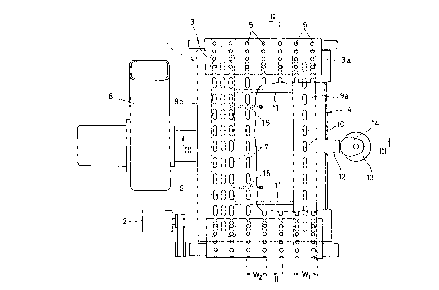Some of the information on this Web page has been provided by external sources. The Government of Canada is not responsible for the accuracy, reliability or currency of the information supplied by external sources. Users wishing to rely upon this information should consult directly with the source of the information. Content provided by external sources is not subject to official languages, privacy and accessibility requirements.
Any discrepancies in the text and image of the Claims and Abstract are due to differing posting times. Text of the Claims and Abstract are posted:
| (12) Patent: | (11) CA 2124997 |
|---|---|
| (54) English Title: | EXPOSURE DEVICE |
| (54) French Title: | DISPOSITIF D'EXPOSITION |
| Status: | Expired and beyond the Period of Reversal |
| (51) International Patent Classification (IPC): |
|
|---|---|
| (72) Inventors : |
|
| (73) Owners : |
|
| (71) Applicants : |
|
| (74) Agent: | SMART & BIGGAR LP |
| (74) Associate agent: | |
| (45) Issued: | 1999-03-09 |
| (22) Filed Date: | 1994-06-02 |
| (41) Open to Public Inspection: | 1994-12-09 |
| Examination requested: | 1996-02-13 |
| Availability of licence: | N/A |
| Dedicated to the Public: | N/A |
| (25) Language of filing: | English |
| Patent Cooperation Treaty (PCT): | No |
|---|
| (30) Application Priority Data: | ||||||
|---|---|---|---|---|---|---|
|
An exposure device for sucking photosensitive
materials of different widths on an exposure table. A
suction belt, driven by a motor, is formed with a plurality
of suction holes uniformly. On the back of the suction
belt is mounted a suction box with a belt support plate
which is formed with a plurality of suction holes. A pair
of adjusting plates are attached to the belt support plate
on its back. By adjusting the position of the adjusting
plates in a width direction, the suction holes in the
outermost rows at both sides are opened and closed. Thus,
the suction width for the suction belt can be adjusted
according to the width of the photosensitive material.
Dispositif d'exposition pour aspirer des matériaux photosensibles de différentes largeurs sur une table d'exposition. Une courroie d'aspiration, entraînée par un moteur, est formée uniformément de nombreux orifices d'aspiration. Une caisse d'aspiration est montée à l'arrière de la courroie d'aspiration avec une plaque de support de courroie formée de nombreux orifices d'aspiration. Deux plaques de réglage sont fixées à l'arrière de la plaque de support de courroie. En réglant la position des plaques de réglage dans le sens de la largeur, les orifices d'aspiration, situés dans les rangées les plus à l'extérieur sur les deux côtés, sont ouverts et fermés. On peut ainsi régler la largeur d'aspiration de la courroie selon la largeur du matériau photosensible.
Note: Claims are shown in the official language in which they were submitted.
Note: Descriptions are shown in the official language in which they were submitted.

2024-08-01:As part of the Next Generation Patents (NGP) transition, the Canadian Patents Database (CPD) now contains a more detailed Event History, which replicates the Event Log of our new back-office solution.
Please note that "Inactive:" events refers to events no longer in use in our new back-office solution.
For a clearer understanding of the status of the application/patent presented on this page, the site Disclaimer , as well as the definitions for Patent , Event History , Maintenance Fee and Payment History should be consulted.
| Description | Date |
|---|---|
| Inactive: IPC from MCD | 2006-03-11 |
| Time Limit for Reversal Expired | 2002-06-03 |
| Letter Sent | 2001-06-04 |
| Grant by Issuance | 1999-03-09 |
| Inactive: Final fee received | 1998-11-17 |
| Pre-grant | 1998-11-17 |
| Notice of Allowance is Issued | 1998-10-01 |
| Notice of Allowance is Issued | 1998-10-01 |
| Letter Sent | 1998-10-01 |
| Inactive: Application prosecuted on TS as of Log entry date | 1998-09-21 |
| Inactive: Status info is complete as of Log entry date | 1998-09-21 |
| Inactive: First IPC assigned | 1998-08-10 |
| Inactive: IPC removed | 1998-08-10 |
| Inactive: IPC assigned | 1998-08-10 |
| Inactive: Approved for allowance (AFA) | 1998-08-10 |
| Request for Examination Requirements Determined Compliant | 1996-02-13 |
| All Requirements for Examination Determined Compliant | 1996-02-13 |
| Application Published (Open to Public Inspection) | 1994-12-09 |
There is no abandonment history.
The last payment was received on 1998-03-20
Note : If the full payment has not been received on or before the date indicated, a further fee may be required which may be one of the following
Please refer to the CIPO Patent Fees web page to see all current fee amounts.
| Fee Type | Anniversary Year | Due Date | Paid Date |
|---|---|---|---|
| MF (application, 4th anniv.) - standard | 04 | 1998-06-02 | 1998-03-20 |
| Final fee - standard | 1998-11-17 | ||
| MF (patent, 5th anniv.) - standard | 1999-06-02 | 1999-04-29 | |
| MF (patent, 6th anniv.) - standard | 2000-06-02 | 2000-05-18 |
Note: Records showing the ownership history in alphabetical order.
| Current Owners on Record |
|---|
| NORITSU KOKI CO., LTD. |
| Past Owners on Record |
|---|
| MASAAKI TSUJI |